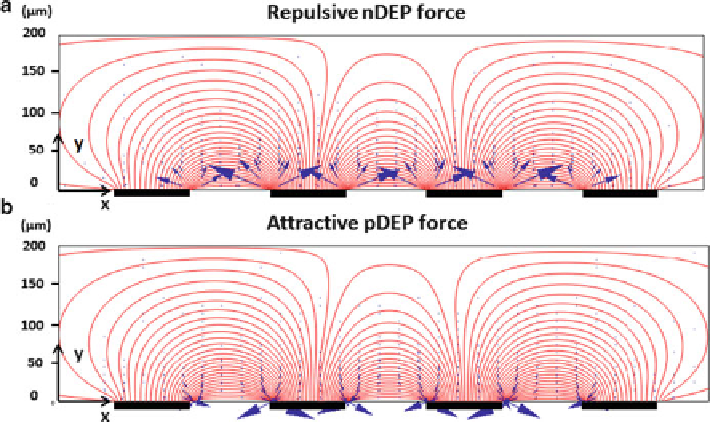Biomedical Engineering Reference
In-Depth Information
Fig. 11.3
Numerical simulation of the contour electric fields (
lines
) and DEP forces (
arrows
)
created by sidewall AgPDMS electrodes (
thick black segments
). (
a
) nDEP forces cause repulsion
of cells away from the electrodes, while (
b
) pDEP forces point towards the electrodes resulting in
attraction of cells. These DEP forces are shown by
arrows
with their length proportional to the
magnitude of force
solutions. The effects of medium conductivity on cellular DEP behavior were
investigated by suspending the cells in 2
s/cm NaCl
solution. Based on (
11.3
) together with (
11.4
) and (
11.5
), the real part of the CM
factor predicts the frequency-dependent DEP responses of yeast and bacterial cells
whether they both experience either pDEP or nDEP, depending on the specific
frequency and buffer solution as shown in Fig.
11.4a
. These predicted behaviors
were computed by basing them on the cell's structural dimensions and dielectric
properties taken from the literature [
27
,
29
]; they were verified experimentally
through the use of conducting PDMS composite electrodes.
Figure
11.4b
presents well dispersed yeast cells in stagnant 380
s/cm DI water and 380
m
m
S/cm NaCl
solution under no applied electric field. With an AC voltage of 10 V at 10 kHz,
yeast cells underwent a repulsive nDEP force and were moved away from the
electrodes (Fig.
11.4c
). This behavior is consistent with the CM factor prediction
which explains that yeast cells are less polarizable than the 380
m
S/cmNaCl solution at
10 kHz. More findings from the literature [
30
-
32
] confirmed that yeast cells tend to
exhibit nDEP in the low frequency regime. On the other hand, at 10 MHz, yeast cells
underwent an attractive pDEP force, thus being transported towards and accumulating
at the electrodes' edges (Fig.
11.4d
). Above 80MHz, noDEPmovement of cells could
be noticed. This was anticipated, since at very high frequencies the computed effective
complex permittivity of yeast cells is rather close to the permittivity of the buffer
solution, the resulting CM factor becomes small at 80 MHz (Fig.
11.4a
). Hence, the
DEP force became insignificant in the experiments. Moreover, the device can
m

Search WWH ::

Custom Search